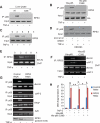Hydrogen sulfide-linked sulfhydration of NF-κB mediates its antiapoptotic actions
- PMID: 22244329
- PMCID: PMC3261430
- DOI: 10.1016/j.molcel.2011.10.021
Hydrogen sulfide-linked sulfhydration of NF-κB mediates its antiapoptotic actions
Abstract
Nuclear factor κB (NF-κB) is an antiapoptotic transcription factor. We show that the antiapoptotic actions of NF-κB are mediated by hydrogen sulfide (H(2)S) synthesized by cystathionine gamma-lyase (CSE). TNF-α treatment triples H(2)S generation by stimulating binding of SP1 to the CSE promoter. H(2)S generated by CSE stimulates DNA binding and gene activation of NF-κB, processes that are abolished in CSE-deleted mice. As CSE deletion leads to decreased glutathione levels, resultant oxidative stress may contribute to alterations in CSE mutant mice. H(2)S acts by sulfhydrating the p65 subunit of NF-κB at cysteine-38, which promotes its binding to the coactivator ribosomal protein S3 (RPS3). Sulfhydration of p65 predominates early after TNF-α treatment, then declines and is succeeded by a reciprocal enhancement of p65 nitrosylation. In CSE mutant mice, antiapoptotic influences of NF-κB are markedly diminished. Thus, sulfhydration of NF-κB appears to be a physiologic determinant of its antiapoptotic transcriptional activity.
Copyright © 2012 Elsevier Inc. All rights reserved.
Figures





Comment in
-
Cysteine 38 holds the key to NF-κB activation.Mol Cell. 2012 Jan 13;45(1):1-3. doi: 10.1016/j.molcel.2011.12.023. Mol Cell. 2012. PMID: 22244324
References
-
- Aracena-Parks P, Goonasekera SA, Gilman CP, Dirksen RT, Hidalgo C, Hamilton SL. Identification of cysteines involved in S-nitrosylation, S-glutathionylation, and oxidation to disulfides in ryanodine receptor type 1. J Biol Chem. 2006;281:40354–40368. - PubMed
-
- Beg AA, Baltimore D. An essential role for NF-kappaB in preventing TNF-alpha-induced cell death. Science. 1996;274:782–784. - PubMed
-
- Beg AA, Sha WC, Bronson RT, Ghosh S, Baltimore D. Embryonic lethality and liver degeneration in mice lacking the RelA component of NF-kappa B. Nature. 1995;376:167–170. - PubMed
Publication types
MeSH terms
Substances
Grants and funding
LinkOut - more resources
Full Text Sources
Molecular Biology Databases
Research Materials
Miscellaneous

